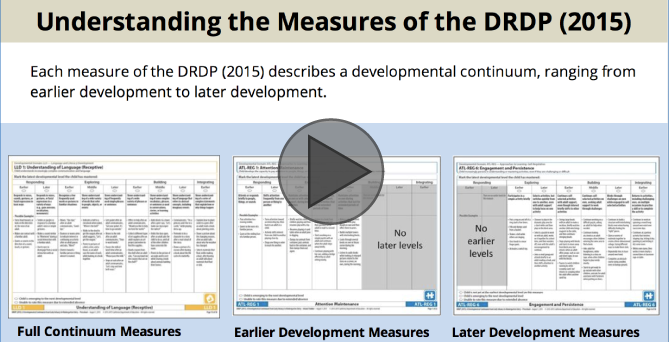
Text Transcript for Understanding the Measures of the DRDP (2015) Interactive Tutorial
Understanding the Measures of the DRDP (2015) |
Each measure of the DRDP (2015) describes a developmental continuum, ranging from earlier development to later development. |
Full Continuum Measures |
|
Start Here |
This page illustrates how information is organized on LLD 1, one of the Full Continuum measures of the DRDP (2015). The Full Continuum measures include levels from early infancy to early kindergarten. Full Continuum measures appear in both the infant/toddler and preschool views of the instrument. Select the buttons to read descriptions of each component. |
Developmental Domain |
The measures in the DRDP (2015) are organized into broad developmental dimensions referred to as Developmental Domains. These Developmental Domains represents an essential area of learning and development for young children. |
Measure |
The Measure is the developmental continuum along which a child’s observed behavior is assessed. Measure LLD 1 is titled "Understanding of Language (Receptive)." |
Definition |
The Definition specifies the aspects of development to be observed. Definitions give us more information about the area of development described in the Measure. The Definition for Measure LLD 1 is "Child understands increasingly complex communication and language." |
Developmental Level |
The Developmental Level is a point along a developmental progression for a particular measure that ranges from earlier development on the left to later development on the right. The levels are organized under four categories: Responding, Exploring, Building, and Integrating. Under each category, you may see the sub-levels Early, Middle, or Later. The broad ages associated with these four categories tell us approximately when we might typically expect to see these skills. Due to their differing ranges, the measures require different numbers of Developmental Levels to describe a continuum. Full Continuum measures include 8 or 9 Developmental Levels and can be found in both the infant/toddler and preschool views of the instrument. |
Descriptors |
The Descriptor defines the behaviors that would be observed for a child at that developmental level. When we rate the measures, we are assessing the child's skills related to these Descriptors. |
Examples |
Examples are behaviors you might see that would demonstrate that a child has reached mastery of a particular developmental level. The Examples help you understand the descriptor, but keep in mind: Examples are just that and should not be used as a checklist. When observing a child, you may not actually observe any or all of them. Very few Examples contain specific adaptations, but you will, however, see them in your observations of a child’s mastery. |
Emerging |
Emerging indicates the child demonstrates skills consistently at one level and is also beginning to demonstrate knowledge, skills, or behaviors described for the next level, although not yet consistently across situations or settings. Documenting emerging behaviors can be useful when talking with families about their child’s progress. |
Unable to rate |
Unable to Rate is to be used only when the child is absent from the program for such an extended period of time during the four to six weeks prior to submitting your DRDP data that you could not gather information to rate the measures. Unable to Rate should hardly ever be used. If you're unable to rate a measure because you don't have enough information, arrange to collect more documentation by making more observations and/or having conversations with others who know the child well. |
Earlier Development Measures |
|
Start Here |
This page describes the Earlier Development measures, using ATL-REG 1 as an example. Earlier Development measures are organized exactly like the Full Continuum measures, so we won't repeat the full descriptions here. The four Earlier Development measures appear in both the infant/toddler and in the preschool views. Select the button to learn how the Earlier Development measures are different from the Full Continuum measures. |
No Later Levels |
The Full Continuum measures include levels from early infancy to early kindergarten. The Earlier Development measures describe development that typically occurs in the infant/toddler and early preschool years and only have developmental levels through Building Earlier. |
Later Development Measures |
|
Start Here |
This page describes the Later Development measures, using ATL-REG 6 as an example. Later Development measures are organized exactly like the full continuum measures, so we won't repeat the full descriptions here. The Later Development measures appear only in the preschool view of the DRDP (2015). Select the buttons to learn how Later Development measures are different from Full Continuum measures. |
No Earlier Levels |
The Full Continuum measures include levels from early infancy to early kindergarten. The Later Development measures describe development that typically occurs in the preschool years and early kindergarten; they do not include the Responding Earlier and Later levels and sometimes do not include Exploring Earlier. |
The “Not Yet” Option |
The option to select “Child is not yet at the earliest developmental level” is available on some of the Later Development measures (it is not an option on the four English Language Development measures). If after careful consideration you determine that a preschool-age child is not yet demonstrating mastery of the earliest level of a Later Development measure, you may select this option. |
